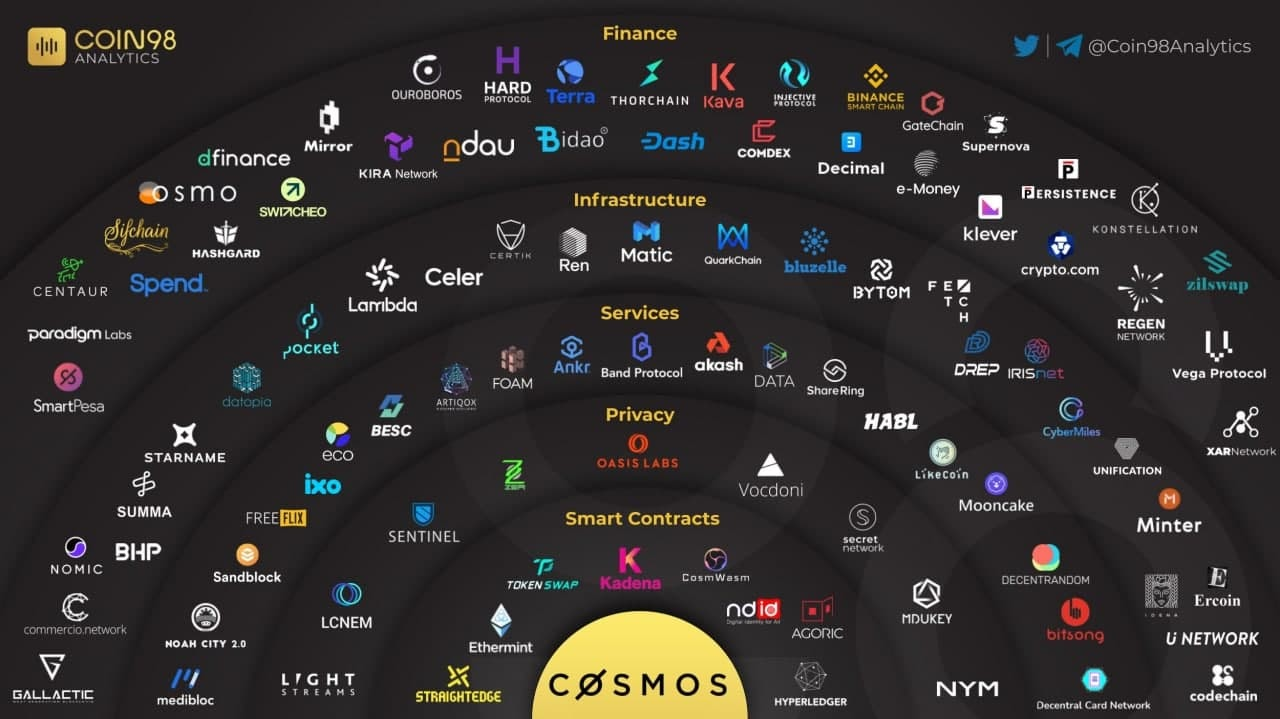The Cosmos We’ve All Been Waiting For
-

In 2023, one of the oldest blockchain ecosystems will begin to deliver on its original promise at the scale many have hoped for.Ethereum introduced the initial concept of smart contracts and, as such, has had a big head start against rival blockchains, being the most developed DeFi ecosystem. However, other blockchains have been taking back market share, each coming forth with its own unique value propositions and use cases in an attempt to build community and, in turn, attract developers and users.
One such blockchain is Cosmos, where Comdex exists. For those new to Cosmos, it can be thought of as an ecosystem of interconnected blockchains, like a hub-and-spoke, with Cosmos Hub at the center.
Applications on Ethereum benefit from its Proof-of-Stake security but suffer from certain trade-offs, such as less potential for project-specific customization and less interoperability with other blockchains. With Cosmos, each application can be its own unique Proof-of-Stake blockchain, opening up the potential for an internet of custom-purpose blockchains in the future.
Despite having a very strong developer ecosystem, Cosmos DeFi itself has, to date, lagged behind other blockchains, in part due to a lack of available stablecoins. This is changing with the announcement of native USDC coming to Cosmos and the rise in crypto-collateralized stablecoins, covered in detail here.
There are several reasons why Cosmos is well-suited for a strong DeFi ecosystem
These include:- Throughput: as each Cosmos application is its own blockchain, they are unaffected by the network congestion as is common with Ethereum.
- Customizability: blockchain functionality and validator sets can be custom-purposed depending on individual needs. For example, dYdX will have its custom validator set to manage transactions off-chain in order to reduce network congestion.
- Control: projects may build vertically, horizontally, or however they see fit. Teams might wish to make their own core technological changes or introduce a new feature.
- Interoperability: as more projects build upon Cosmos, network effects grow. Each blockchain will be able to communicate seamlessly and securely with one another using the Inter-Blockchain Communication (IBC) protocol.
- Gas Fees: gas fees are now paid in the native token of the protocol, meaning that value accrues to their token rather than to another blockchain network such as Ethereum.
dYdX’s recent move over to Cosmos has also gained widespread attention, and if successful, may lead to others following suit. All in all, as stablecoins become more widely available within Cosmos and more projects begin to see the benefits of building there, the future may be well-poised for future growth.
The Path Forward for Cosmos DeFi
Our goal is to democratize finance by building an infrastructure layer optimized for aggregating cross-chain liquidity with a suite of cutting-edge DeFi products. The primary means of doing this is by providing modules built on the core primitives of finance, allowing builders to utilize them to launch DeFi applications.
Builders can now benefit from Comdex’s customizable modules, whether that be primitives for functionalities such as liquidations, lending, oracles, vaults, assets, or much more. This will be extremely relevant as more and more projects come to Cosmos in the future, requiring reliable and customizable infrastructure that’s interoperable with the rest of the Cosmos ecosystem.
On the consumer side, Comdex is building out a suite of services such as:
- CMST: our crypto collateralized stablecoin, mintable through Harbor Protocol.
- C-Swap: our decentralized exchange.
- Commodo: our borrowing and lending market.
Ethereum projects including Curve, Aave, and Frax have been racing to provide all three of the above solutions. For example, Curve is introducing its own stablecoin, while Frax has introduced its own AMM and borrowing/lending market.
Comdex already has all of the above, which can be used by other projects wishing to deploy. With the Comdex chain, builders have access to a stack of modules that allow smoother go-to-market for any dApp launching in Cosmos. The Comdex chain, therefore, acts as the de facto infrastructure layer of interchain DeFi.
About Siddarth Patil
Comdex Co-founder and COO. Before co-founding Comdex, Siddarth’s professional endeavors centered on finance, with working experience in wealth management and investment banking. He began building Comdex in 2018 as a blockchain-based solution to digitize the commodity supply chain industry. Along with the Comdex team, Siddarth launched Comdex chain in 2021 as a DeFi infrastructure layer to power a multi-chain ecosystem.
About Comdex
A DeFi infrastructure layer for the Cosmos ecosystem. A layer-1 infrastructure for seamless deployment of DeFi applications in the Cosmos ecosystem, powering DeFi in the multi-chain future.The Comdex chain is built to enable the bridging of capital to assets across the DeFi and CeFi ecosystems. A truly decentralized ecosystem of solutions enables limitless access to global liquidity in finance.
Comdex aims to deliver a robust infrastructure layer that supports the seamless creation and deployment of DeFi applications in the Cosmos ecosystem. The Comdex chain enhances investors’ access to a broad range of assets that help investors diversify and generate yield on their investments.
Srouce: https://hackernoon.com/the-cosmos-weve-all-been-waiting-for
Source: Coin98 analytics
